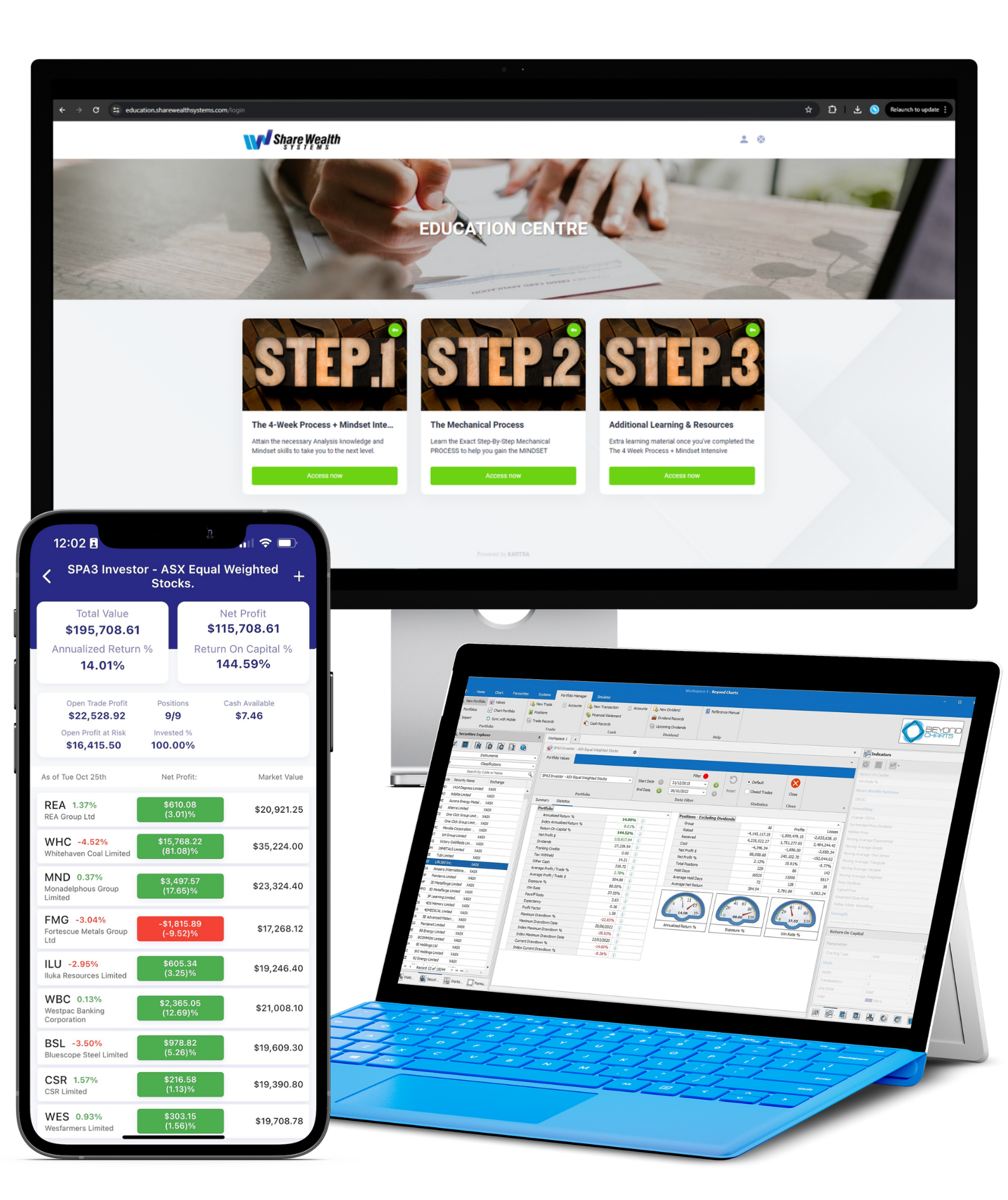
Don’t let the financial establishment convince you the only way to profit in the stock market is to stay invested all the time. (Bonus points if you are invested with them, of course.)
The “proof” they base this statement on is bogus, as I’ll show you in a moment. But before I do that, let me be clear about one thing:
I’m not against the “time in the market” concept. It works. But so does timing the market.
In fact, I use both. Which one works best depends on your investing goals and how you’d like to spend your time.
With that settled, let’s break down the argument that “shows” timing the market can only lead to losses.
Busting The “Market Timing Doesn’t Work” Myth
The story the financial establishment tells is this:
If you try to time the market and miss out on the 10 best return days in a 10-year period…
You forfeit all potential gains during that period and end up with a small loss overall. Things get worse and 10-year losses become larger and larger if you miss 20, 30, 40, etc., days.
In theory, this story is true.
In practice, it’s manipulative misinformation.
Just answering two simple questions and completing the ensuing analysis demonstrates why my previous sentence is spot on:
- What happens if you miss the 10 WORST days?
- What happens if you miss BOTH the 10 best and 10 worst days?
Here’s what the research tells us:
In a 10-year period, missing the worst days has a positive effect that’s bigger than the negative effect of missing the same number of best days.
In plain English, you get a better outcome if you miss the same number of worst and best days than if you stay in the market all the time.
Now imagine what would happen if you could time the market to miss ONLY the worst days. Or at least to miss more worse than best days.
But don’t stop with the questions here. Also ask WHEN do the best and worst return days occur?
All it takes is a simple analysis to see that the answer is in close proximity to each other.
Why is this vital information?
Well, because it implies it’s virtually impossible to miss the best days without also missing the worst days.
Okay, enough with the theory. Let’s look at some actual data that confirms my “manipulative misinformation” statement.
In the ten-year period which includes the 2008 bear market, the two best single day gains (11.58% and 10.79%) occurred in October 2008. During the same month, the S&P500 fell 22.48%. And there’s more…
The 1st, 3rd, 4th, 8th, and 9th worst days of the entire ten years also happened that October.
In 1987, we had a similar October. The three best days and the 1st, 3rd, 8th and 9th worst days over ten years all occurred in that -20.47% month.
So, the data leads us to the conclusion that aiming to miss the market’s best days is a viable strategy. Because by doing that you ensure you’ll also miss the worst days and months…
Which leads to a superior investing outcome.
Now, timing the market day-by-day is challenging and time-consuming. But timing on a longer-term basis to avoid the worst months of large bear markets can do wonders for your compound returns. If done right, of course.
So, let me show you the prerequisites for “doing it right.”
How To Lay The Groundwork For A Profitable Long-Term Market Timing Strategy
For your timing criteria to actually work and help you avoid the most of bear markets (and get the most out of bull markets)…
They must be objective.
Meaning the criteria must be clear, concise, consistent, and constant. You don’t change them based on assumptions, opinions, predictions, or other types of noise.
To build such timing criteria, you need to research lots and lots of historical stock price data. Or use done-for-you criteria someone else developed in such a manner.
In other words, you need a systematic process with a verified and research-backed Statistical Edge.
Sure, it’s possible to build objective timing criteria even without a systematic process. But this implies you have to research what and when to buy and when to sell for EVERY trade from scratch.
If you go down this route, be ready for hours and hours of reading and research before every investment decision you make.
With a systematic process, you only do the timing research once. And you do it before you invest a single cent in the market. Then you can successfully repeat the timing criteria in the future over and over again.
This route turns time spent on making investment decisions from hours to minutes per day.
One caveat:
A systematic process will only produce winning long-term results if it’s researched in the market’s probabilistic environment. And based on the “language” of the market (the price action).
Only then will your investing decisions reflect a market paradigm instead of a societal one. This is critical because the latter will crush your investing endeavours.
How Do You Know If Your Timing Criteria Will Produce Results BEFORE You Start Investing
This is where the verified Statistical Edge I mentioned earlier comes in. It shows you how good your timing criteria actually are.
Of course, this Edge works in probabilities, not in certainties. So, you can’t know with 100% certainty if your timing criteria will work…
Nor will they ever save you from all losses.
But with a big enough positive Statistical Edge, you will maximize the chances of winning in the long run.
To ensure you have one, you must put your timing criteria through rigorous testing.
For example, I’ve used historical back-testing & portfolio simulation research for over 25 years to test SPA3 Investor’s Statistical Edge before taking it to live execution.
In contrast, most people follow stock tips with no knowledge about the tipster’s Statistical Edge and no predefined exit criteria for that tip.
Then it’s no wonder those people agree market timing doesn’t work and go back to investing with the financial establishment.
IMO, you shouldn’t even try to time the market without being 100% sure your timing system has a positive Statistical Edge.
Because when it does, your chances of achieving long-term market-beating returns that outperform nearly all hedge and mutual/managed funds skyrocket.
That’s how important having a verified and stress-tested Statistical Edge is. And that’s why I’ll devote an entire article next week to show you how to ensure you have one.
Stay tuned.
P.S. If you want early access to that article, subscribe here.


